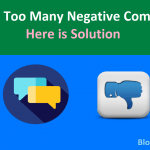Many SEO’s are happy to play by the rules- they publish their content, promote their work on social media and carry on with Google’s algorithm updates.
But sometimes someone can try to disturb your peace. Negative SEO can make considerable damage to a site through malicious backlink spamming as well as through the use of other malicious tactics.
As a result, it can pose a very legitimate danger which can result in a loss of revenue as well as of search visibility.
Contents In Page
But, What is Negative SEO?
Negative SEO- it is a term which is attributed to the use of black hat SEO techniques on some other site.
This can be done on your website or blog throw the peoples who jealous you or can be done by your competitor.
But there is no need to worry about that because you can easily safe your website from negative SEO attack with our very easy tips.
Who can carry out a Negative SEO attack?
It can be carried out by a competitor and their followers who want to reduce a particular site’s rankings.
One example of this occurring is through guest posts as no matter the type of post written- the post will be linked to the guest’s site and so on.
This makes it possible for the post to be circulated and linked back to your site from a lot of places and you might not even know about them
But there are ways through which you can avoid them or catch them:
Check before asking
Since prevention is better than cure so before asking anyone to guest post do a credential and background check on them to see if they are reputable or not.
A quick check can end up saving your time, energy and money.
Keep an eye on your Keywords
Monitoring your keywords can save from attacks which can result in degrading your ranking. To spot this-
First, log into the Google Search Console
Then select Search Traffic and check your CTR on all keywords
If you find an unusual spike for which you can’t find a reason then contact Google and start disavowing the links.
Always make sure to go through regular link checks/audits
Regular link checks are a beneficial practice to have for any business and it can save your blog in time if you fall victim to a negative SEO attack.
If you notice a huge drop or spike in link building but you haven’t been working on it then it should alert you to the fact that something is wrong. So always keep on your toes and monitor your the growth of your link profile to weed out any suspicious activities before it goes beyond your control.
You can do this by using a link auditing software or you can carry this out by doing a manual check on your backlinks. If you find any spammy links then disavow them and let Google know.
Look for scraped content
Content is king but one should also know how to be creative while making it so as to draw crowds.
This results in scrapping, which is the technique of straight uplifting content from the target websites and then copying it without making any changes to it.
Generally, it is done by attackers who are looking to expand on their thin content, but it is also possible that they might combine it up with a spam farm attack. While it may sound harmless, but scraping can result in falling rankings if the copied content is indexed before yours, which will result in your page getting devalued.
A tool called Copyscape can help you discover if someone has plagiarized your content. If you find someone has done so, then ask them to remove it. If they fail to comply then fill out Google’s Copyright Removal form to report them.
Check to confirm if you have been hacked
It should be kept in mind that links might suffer if you have been encroached and hacked. It could be possible for an attacker to alter your posts and other content to put in spam links or maybe the could also modify the links so that they redirect to where they want.
Now, these attacks can be hard to spot and the only way you can safeguard your blog or website could be to perform website audits.
Don’t forget to monitor your site on Google My Business
Nobody wants their reputation which they have worked hard to build to tank, but negative reviews do provide a learning g opportunity.
But maybe it’s time to question if there is a huge wave of negative reviews. So if you haven’t done something which would count as a PR blunder then the negative reviews can be a sign that someone is trying to intentionally tank your business.
Without quick action, your reputation can take a hit.
For this, always keep an eye on Google My Business listing as well on your social media reputation.
Here’s how you can report fake reviews:
- Search up your business on Google Maps.
- Then select what is yours from the results.
- Then click on Review Summary present in the left panel.
- Flag all the fake reviews.
- Now fill out the report form.
Check up on the SERP Ranking
A visible drop in rankings could be attributed to a malicious attack. While a complete de-indexing doesn’t happen but if you do see a visible drop then use rank tracking software to check your visibility. Then check on the site’s crawl stats on Google Search Console and ultimately ensure that your robots.txt are still correctly set up.
Always monitor the site speed
You have come to notice over time that your website is taking more time to load but you can’t figure out why it is happening. If these are the circumstances then it’s time you used a crawling software to look around for anything that could be suspicious. If it still doesn’t work then you could be the target of forceful crawling which can result in heavily server loads so that your site slows down or crashes. In these conditions, contact the webmaster or hosting company to determine where the excess load is generating from.
While negative SEO is quote rare but unfortunately it is present. But if it is caught quickly then the problem can be solved without any visible damage to your business or reputation.





![How To Increase Google Search Crawl Rate Of Website[Tips & Methods] How To Increase Google Search Crawl Rate](https://www.blogbeginner.com/wp-content/uploads/2019/03/How-To-Increase-Google-Search-Crawl-Rate-150x150.png)


